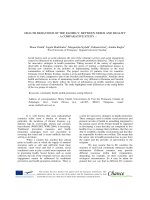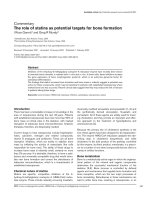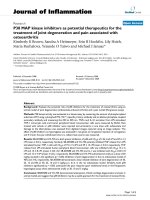Germanene as potential material for sensor of toxic gases CO2, SO2, and CH4: A DFT study
Bạn đang xem bản rút gọn của tài liệu. Xem và tải ngay bản đầy đủ của tài liệu tại đây (406.29 KB, 12 trang )
Germanene as potential material for sensor of toxic gases CO2, SO2,
and CH4: A DFT study
Nguyen Trung Hieu1, Nguyen Duy Khanh1, Le Vo Phuong Thuan1, Vo Duy Dat1, Hoang
Van Ngoc1, Nguyen Thanh Tung1, Huynh Thi Phuong Thuy1, Mai Quang Vinh1, Tran Thi
Hong Anh1, Mai Thi Hao1, and Vo Van On1,*
1
Group of Computational Physics and Simulation of Advanced Materials, Institute of Applied
Technology, Thu Dau Mot University, Binh Duong Province, Viet Nam
*Corresponding at
Abstract
The adsorption of common gas molecules (CO2, SO2, and CH4) on germanene is studied using
the density functional theory. The structural characteristics of gases adsorbed germanene are
analyzed in the adsorption energy as a function of adsorption distance. The results show that
gases of CO2, SO2, and CH4 are physically adsorbed on germanene via a charge transfer
mechanism. The physisorption of these gas molecules on germanene opens a band gap at the
Dirac point of germanene. The different adsorption behaviors of gas molecules on germanene
provide a feasible way to extend germanene for gas sensors.
Keywords: germanene, adsorbtion, first-principles calculations, toxic gases.
1. Introduction
The single-layer structure of graphite was theoretically discovered and named graphene in
1947 by Wallace P. R. [1]. However, it was not until 2004 that graphene was mechanically
exfoliated from graphite, and it has attracted enormous experimental and theoretical interest [2,3]
due to unusual properties [4]. One of the most important graphene applications is the gas sensor,
thanks to its large surface area, low electrical noise, and too high electron mobility [5,6]. On the
other hand, pristine graphene's sensitivity is limited by common gas molecules' physisorption
[7]. This obstacle can be overcome by introducing defect and substitutional doping graphene to
modify its electronic properties [8–10], leading to numerous challenges [11,12]. Recently, both
silicene and germanene have attracted increasing attention due to their analogs of 2D structures
to graphene, which allows them to be a potential replacement for graphene and overcome
graphene's limitations. While silicene was successfully grown on Ag [13–16], Ir [17], and ZrB2
[18] substrates, germanene was reported to be grown on Pt(111) [19]. Germanane, multilayer
hydrogen-terminated germanene, has also been synthesized and then mechanically exfoliated to a
single layer onto SiO2/Si surface [20]. Both silicene and germanene show outstanding properties
similar to those of graphenes, such as high carrier mobility[21], ferromagnetism [22], halfmetallic [23], quantum hall effect [24], and a topological insulator [25]. Interestingly, because of
its buckled honeycomb structure [26], silicene exhibits a significantly higher chemical reactivity
6
than graphene, showing much stronger adsorption of atoms [27–33] and molecules [34–38] than
graphene with good potential applications on new silicene based nanoelectronic devices [26],
Li-ion storage batteries [30], hydrogen storage [31], catalysts [32], thin-film solar cell absorbers
[33], helium [35] and hydrogen [36] separation membranes, molecule sensor and detection.
However, silicene on metal substrates does not exhibit these properties, and the properties of
silicene on low dimensional materials, e.g., graphene, is considerably closer to pristine silicene
[39]. Recently, atom adsorption on germanene is also studied [37,38]. Similar to silicene, atoms
bind much stronger to germanene than graphene, which is mainly caused by the sp2–sp3
hybridization of the Ge atom. However, little attention has been focused to molecule adsorption
on germanene. In this study, a systematic investigation of CO2, SO2, and CH4 molecules'
adsorption behavior on germanene is performed to propose germanene as a promising sensor for
these toxic gases.
2. Computational Methods
All calculations based on the density functional theory were implemented in the Vienna Ab
Initio Simulation Package (VASP) [40]. Because the van der Waals functionals are expected to
be better than van der Waals correction schemes [41,42], the van der Waals interaction was taken
into account in all calculations by employing the PBE - vdW functional [43–45] for the aim to
produce the results in better agreement with experiment [46,47]. The adsorption configuration,
the potential energy surface (PES), and adsorption energy profile were calculated. To eliminate
the interaction between two adjacent periodic images, a vacuum layer of 20 Å was added into the
4 x 4 supercell of the pristine germanene. Cutoff energy of 450 eV for the plane-wave basis set
and a 3x3x1 Gamma centered k-point mesh was utilized to yield the energy convergence. All
structures were fully relaxed until the maximum Hellmann-Feynman force acting on each atom
is less than 0.03 eV/Å. The charge transfer between Ge substrate and CO2, SO2, and CH4 gases
was calculated based on the Bader charge transfer scheme [48].
3. Results and discussion
3.1 Structure Stability
The structural optimization processes achieved the optimal configurations of the CO2, SO2, and
CH4 on germanene. The adsorption at top, valley, hollow, and bridge sites were considered for
each molecule on the germanene surface to find the most favorable structure corresponding to
the lowest total energy. The most stable adsorption configurations are shown in Fig.1, where the
CO2 molecule is preferably located on the top site of germanene. In contrast, the carbon atom is
bonded with the Ge atom, the two oxygen atoms, from a straight angle. The SO2 molecule
prefers to stay at the valley site. Consequently, the two oxygen atoms interact with Ge atoms
obtuse angle. The tetrahedral structure's symmetry allows the CH4 molecule to stay nearly at the
center of the hollow site, with three hydrogen atoms pointing parallelly in the in-plane direction
and one hydrogen atom pointing along the out-of-plane direction.
7
Figure 1: The top- and side-views of the most stable configurations of the CO2, SO2, and CH4
gases adsorbed on germanene. The purple, red, yellow, and white balls are carbon, oxygen,
sulfur, and hydrogen atoms.
To evaluate the adsorption nature of gas molecules on germanene, the adsorption energy is
defined as follows:
Ead = Etotal- Egas-EGermanene
Etotal, Egas, and EGermanene are the ground-state total energy of the total system, the gas
molecule, and pristine germanene. As the definition adopted here, negative adsorption energy
exhibits that the process is exothermic while the magnitude signifies thermodynamic stability.
Based on the magnitude of Ead, the equilibrium distances between gas molecules and
germanene’s surface (adsorption distance) are defined. As shown in Fig.2, the adsorption energy
strongly depends on the adsorption distance. Therefore, it is very important to consider the
adsorption distance in a large range of values to accurately define the minimum adsorption
energy. The adsorption energies of CO2, SO2, and CH4 on germanene are -0.131 meV, -0.285
meV, and -0.144 meV, respectively. The corresponding adsorption distance between CO2, SO2,
CH4, and germanene surface is 3.413 Å, 3.628 Å, and 3.367 Å, respectively. The very small low
adsorption energies confirm the physical nature of molecule adsorption on germanene.
8
Figure 2: Adsorption energy profiles of adsorption configurations: a) CO2, b) SO2, c) CH4.
The molecule adsorption shifts the CO2, SO2, and CH4 closer to Ge atoms, causing orbitals'
splitting near the Fermi level. As a result, the germanene bandgap is significantly modified,
depending on the adsorption distance and adsorption molecule. Due to the larger atomic radius of
S compared with C, the bandgap of CO2/Ge increases from 4.3 meV to 29.3 eV of SO2/Ge, while
the bandgap of CH4/Ge is only 1.3 meV. However, this theoretical prediction also depends on the
calculation methods. For comparison, the adsorption energy (Ead), adsorption distance (d), and
the bandgap (Eg) from the current study and other published works are presented in table 1.
There is a noticeable difference in the bandgap calculated by GGA + DFT-D2, and DFT + NEGF
methods, which reveal 11 meV [49], and 0.00 eV [50], respectively. However, the DFT + NEGF
method results in the same band gap increasing from CO2/Ge to SO2/Ge.
9
Table 1: Energy adsorption (Ead), adsorption distance (d), band gap (Eg) of germenene after
adsorbed gas molecules
Sample
CO2/Ge
SO2/Ge
CH4/Ge
Adsorption Energy (eV)
-0.131 a
0.42 d, 0.1 e
-0.285 a
-0.144 a
1.56 d
-0.114 b,
0.231 d
Adsorption distance (Å)
3.413 a
3.32 e
3.628 a
3.367 a
3.36 b
a
Current study by GGA + DFT-D2
b
GGA DFT-D2 [51]
c
DFT + nonequilibrium Green’s function (NEGF) [52]
d
GGA + DFT-D2 [50]
e
GGA + DFT-D2 [49]
Band gap (meV)
4.3 a
0.00 d
11 e
29.3 a
140 d
1.3 a
3.2 b, 3.9 d
3.2 Electronic properties
The charge transfer between gas molecules and Ge p-orbitals near the Dirac points can induce a
local electric potential to break the symmetry of sub-lattice in germanene. Consequently, some
band gap is created at the Dirac points, as shown in Fig. 3, and the shape of Dirac points is nearly
unchanged. While CO2 and CH4 molecules' adsorption induce some meV bandgap, the SO2
molecule causes a more recognizable bandgap of nearly 0.3 eV. Although the form of both the
highest occupied molecular orbitals (HOMO) and lowest unoccupied molecular orbitals (LUMO)
is almost unchanged in three adsorption cases, there are some changes at higher orbitals of the
conduction band. This signifies some weak hybridization between orbitals of gas and the Ge porbitals, especially in the case of SO2 molecule. The orbital interaction is elucidated by
considering the difference in the density of state (DOS) between Ge-gas and Ge systems, as
shown in Fig.4. It can be seen in Fig. 4(c) that the blue peak (total DOS) and the red peak (DOS
of Ge) within the energy levels ranging from -1 eV to 1 eV almost overlap each other, indicating
very weak orbital interaction. Meanwhile, the discrepancy of these peaks in Ge/CH4 and Ge/SO2
is bigger, leading to a wider bandgap. The more remarkable discrepancy between the blue and
red peaks occurs at the same energy levels lower than -2 eV or higher than 2 eV. However, these
orbital interactions do not affect the magnitude of the bandgap.
10
Figure 3: Electronic band structure of a) CO2/Germanene ; b) SO2/Germanene and c)
CH4/Germanene.
11
Figure 4: Density of states (DOS) in the adsorption of a) CO2/Germanene, b) SO2/ Germanene
and c) CH4/Germanene
At energy levels lower than -4 eV or higher than 4 eV, single high blue peaks indicate the
asymmetric distribution of charge near the adsorbing gas molecules. As the charge distribution
reveals the bonding character, the charge density difference (CDD) was calculated and presented
in Fig. 5. There is a slight electron depletion around the CO2 molecule together with a small
electron accumulation near the C atom, and a larger electron concentration between C and
Germanene's surface, indicating the weak covalent nature of C-Ge bonding. It is worthy to notice
that the charge transferred from Germanene to CO2 molecule, -0.037e, is mainly concentrated on
C atoms signifying the weak interaction between C-2p and Ge-2p orbitals. It can be seen in Fig.
5(b) that the electron density on C and O atoms is nearly the same. Moreover, the electron
concentration in the area between SO2 molecule and Germanene is also small. Therefore, the
charge transfer from Ge to SO2 is small, which is about -0.027e. The charge transfer to CH4 is 0.175e, indicating the ionic character of the bonding between Ge and CH4 molecule. Therefore,
12
the electron is concentrated mostly on the CH4 molecule, as shown in Fig. 5(c), and a smaller
electron density is found on the Germanene.
Figure 5: Charge density difference (CDD) in the a) CO2/Germanene, b) SO2/ Germanene and c)
CH4/Germanene compounds, in which the yellow and blue iso-surfaces represent electron gain
and depletion, respectively.
4. Conclusion
The first-principles calculations are performed to investigate the structural and electronic
properties of germanene adsorbed with several small gas molecules, including CO2, SO2, and
CH4. In contrast to graphene, all gas molecules are predicted to bind weakly to germanene’s
surface due to the hybridized sp2-sp3 bonding of Ge atoms. It was found out that all three gas
molecules are physisorbed on germanene through the weak charge transfer mechanism. Besides,
the sizable band gaps of 1.3 to 29.3 meV are opened at the Dirac point of germanene under CO2,
13
SO2, and CH4 adsorptions, while only slight modification of the Dirac cone shape is observed.
The negative charge transferred from germanene to all three gases indicates that CO2, SO2, and
CH4 are electron acceptors in the germanene adsorption. Overall, different adsorption behaviors
of gas molecules on germanene provide a feasible way to extend germanene for a wide range of
practical applications, such as gas sensors.
References
[1]
Wallace P R 1947 The Band Theory of Graphite Phys. Rev. 71 622–34
[2]
Geim A K and Novoselov K S 2007 The rise of graphene Nat. Mater. 6 183–91
[3]
Castro Neto A H, Guinea F, Peres N M R, Novoselov K S and Geim A K 2009 The
electronic properties of graphene Rev. Mod. Phys. 81 109–62
[4]
Novoselov K S, Geim A K, Morozov S V, Jiang D, Zhang Y, Dubonos S V, Grigorieva I
V and Firsov A A 2004 Electric Field Effect in Atomically Thin Carbon Films Science vol
306 pp 666 LP – 669
[5]
Choi J H, Lee J, Byeon M, Hong T E, Park H and Lee C Y 2020 Graphene-Based Gas
Sensors with High Sensitivity and Minimal Sensor-to-Sensor Variation ACS Appl. Nano
Mater. 3 2257–65
[6]
Schedin F, Geim A K, Morozov S V, Hill E W, Blake P, Katsnelson M I and Novoselov
K S 2007 Detection of individual gas molecules adsorbed on graphene Nat. Mater. 6 652–
5
[7]
Leenaerts O, Partoens B and Peeters F M 2008 Adsorption of H2O, NH3, CO, NO2, and
NO on graphene: A first-principles study Phys. Rev. B 77 125416
[8]
Zhang Y-H, Chen Y-B, Zhou K-G, Liu C-H, Zeng J, Zhang H-L and Peng Y 2009
Improving gas sensing properties of graphene by introducing dopants and defects: a firstprinciples study Nanotechnology 20 185504
[9]
Ni S, Li Z and Yang J 2012 Oxygen molecule dissociation on carbon nanostructures with
different types of nitrogen doping Nanoscale 4 1184–9
[10]
Dai J and Yuan J 2010 Adsorption of molecular oxygen on doped graphene: Atomic,
electronic, and magnetic properties Phys. Rev. B 81 165414
[11]
Terrones H, Lv R, Terrones M and Dresselhaus M S 2012 The role of defects and doping
in 2D graphene sheets and 1D nanoribbons Reports Prog. Phys. 75 62501
[12]
Tian W, Li W, Yu W and Liu X 2017 A Review on Lattice Defects in Graphene: Types,
Generation, Effects and Regulation ed H D Ngo Micromachines 8 163
[13]
Feng B, Ding Z, Meng S, Yao Y, He X, Cheng P, Chen L and Wu K 2012 Evidence of
Silicene in Honeycomb Structures of Silicon on Ag(111) Nano Lett. 12 3507–11
14
[14]
Vogt P, De Padova P, Quaresima C, Avila J, Frantzeskakis E, Asensio M C, Resta A,
Ealet B and Le Lay G 2012 Silicene: Compelling Experimental Evidence for
Graphenelike Two-Dimensional Silicon Phys. Rev. Lett. 108 155501
[15]
Chen L, Liu C-C, Feng B, He X, Cheng P, Ding Z, Meng S, Yao Y and Wu K 2012
Evidence for Dirac Fermions in a Honeycomb Lattice Based on Silicon Phys. Rev. Lett.
109 56804
[16]
Chen L, Li H, Feng B, Ding Z, Qiu J, Cheng P, Wu K and Meng S 2013 Spontaneous
Symmetry Breaking and Dynamic Phase Transition in Monolayer Silicene Phys. Rev. Lett.
110 85504
[17]
Meng L, Wang Y, Zhang L, Du S, Wu R, Li L, Zhang Y, Li G, Zhou H, Hofer W A and
Gao H-J 2013 Buckled Silicene Formation on Ir(111) Nano Lett. 13 685–90
[18]
Fleurence A, Friedlein R, Ozaki T, Kawai H, Wang Y and Yamada-Takamura Y 2012
Experimental Evidence for Epitaxial Silicene on Diboride Thin Films Phys. Rev. Lett. 108
245501
[19]
Li L, Lu S, Pan J, Qin Z, Wang Y, Wang Y, Cao G, Du S and Gao H-J 2014 Buckled
Germanene Formation on Pt(111) Adv. Mater. 26 4820–4
[20]
Bianco E, Butler S, Jiang S, Restrepo O D, Windl W and Goldberger J E 2013 Stability
and Exfoliation of Germanane: A Germanium Graphane Analogue ACS Nano 7 4414–21
[21]
Bechstedt F, Matthes L, Gori P and Pulci O 2012 Infrared absorbance of silicene and
germanene Appl. Phys. Lett. 100 261906
[22]
Wang X-Q, Li H-D and Wang J-T 2012 Induced ferromagnetism in one-side
semihydrogenated silicene and germanene Phys. Chem. Chem. Phys. 14 3031–6
[23]
Wang Y, Zheng J, Ni Z, Fei R, Liu Q, Quhe R, Xu C, Zhou J, Gao Z and Lu J 2012 Halfmetallic silicene and germanene nanoribbons: towards high-performance spintronics
device Nano 07 1250037
[24]
Ma Y, Dai Y, Niu C and Huang B 2012 Halogenated two-dimensional germanium:
candidate materials for being of Quantum Spin Hall state J. Mater. Chem. 22 12587–91
[25]
Si C, Liu J, Xu Y, Wu J, Gu B-L and Duan W 2014 Functionalized germanene as a
prototype of large-gap two-dimensional topological insulators Phys. Rev. B 89 115429
[26]
Kara A, Enriquez H, Seitsonen A P, Lew Yan Voon L C, Vizzini S, Aufray B and
Oughaddou H 2012 Corrigendum to “A review on silicene—New candidate for
electronics” [Surf. Sci. Rep. 67 (2012) 1–18] Surf. Sci. Rep. 67 141
[27]
Lin X and Ni J 2012 Much stronger binding of metal adatoms to silicene than to
graphene: A first-principles study Phys. Rev. B 86 75440
[28]
Sivek J, Sahin H, Partoens B and Peeters F M 2013 Adsorption and absorption of boron,
15
nitrogen, aluminum, and phosphorus on silicene: Stability and electronic and phonon
properties Phys. Rev. B 87 85444
[29]
Sahin H and Peeters F M 2013 Adsorption of alkali, alkaline-earth, and 3$d$ transition
metal atoms on silicene Phys. Rev. B 87 85423
[30]
Tritsaris G A, Kaxiras E, Meng S and Wang E 2013 Adsorption and Diffusion of Lithium
on Layered Silicon for Li-Ion Storage Nano Lett. 13 2258–63
[31]
Wang J, Li J, Li S-S and Liu Y 2013 Hydrogen storage by metalized silicene and silicane
J. Appl. Phys. 114 124309
[32]
Li C, Yang S, Li S-S, Xia J-B and Li J 2013 Au-Decorated Silicene: Design of a HighActivity Catalyst toward CO Oxidation J. Phys. Chem. C 117 483–8
[33]
Huang B, Xiang H J and Wei S-H 2013 Chemical Functionalization of Silicene:
Spontaneous Structural Transition and Exotic Electronic Properties Phys. Rev. Lett. 111
145502
[34]
ệzỗelik V O and Ciraci S 2013 Local Reconstructions of Silicene Induced by Adatoms J.
Phys. Chem. C 117 26305–15
[35]
Hu W, Wu X, Li Z and Yang J 2013 Helium separation via porous silicene based ultimate
membrane Nanoscale 5 9062–6
[36]
Hu W, Wu X, Li Z and Yang J 2013 Porous silicene as a hydrogen purification
membrane Phys. Chem. Chem. Phys. 15 5753–7
[37]
Hu W, Xia N, Wu X, Li Z and Yang J 2014 Silicene as a highly sensitive molecule sensor
for NH3, NO and NO2 Phys. Chem. Chem. Phys. 16 6957–62
[38]
Feng J, Liu Y, Wang H, Zhao J, Cai Q and Wang X 2014 Gas adsorption on silicene: A
theoretical study Comput. Mater. Sci. 87 218–26
[39]
Berdiyorov G R, Neek-Amal M, Peeters F M and van Duin A C T 2014 Stabilized
silicene within bilayer graphene: A proposal based on molecular dynamics and densityfunctional tight-binding calculations Phys. Rev. B 89 24107
[40]
Kresse G and Furthmüller J 1996 Efficient iterative schemes for ab initio total-energy
calculations using a plane-wave basis set Phys. Rev. B 54 11169–86
[41]
Ramalho J P P, Gomes J R B and Illas F 2013 Accounting for van der Waals interactions
between adsorbates and surfaces in density functional theory based calculations: selected
examples RSC Adv. 3 13085–100
[42]
Vlaisavljevich B, Huck J, Hulvey Z, Lee K, Mason J A, Neaton J B, Long J R, Brown C
M, Alfè D, Michaelides A and Smit B 2017 Performance of van der Waals Corrected
Functionals for Guest Adsorption in the M2(dobdc) Metal–Organic Frameworks J. Phys.
Chem. A 121 4139–51
16
[43]
Dion M, Rydberg H, Schröder E, Langreth D C and Lundqvist B I 2004 Van der Waals
Density Functional for General Geometries Phys. Rev. Lett. 92 246401
[44]
Román-Pérez G and Soler J M 2009 Efficient Implementation of a van der Waals Density
Functional: Application to Double-Wall Carbon Nanotubes Phys. Rev. Lett. 103 96102
[45]
Klimeš J, Bowler D R and Michaelides A 2009 Chemical accuracy for the van der Waals
density functional J. Phys. Condens. Matter 22 22201
[46]
Hamada I and Otani M 2010 Comparative van der Waals density-functional study of
graphene on metal surfaces Phys. Rev. B 82 153412
[47]
Berland K, Cooper V R, Lee K, Schröder E, Thonhauser T, Hyldgaard P and Lundqvist B
I 2015 van der Waals forces in density functional theory: a review of the vdW-DF method
Reports Prog. Phys. 78 66501
[48]
Henkelman G, Arnaldsson A and Jónsson H 2006 A fast and robust algorithm for Bader
decomposition of charge density Comput. Mater. Sci. 36 354–60
[49]
Xia W, Hu W, Li Z and Yang J 2014 A first-principles study of gas adsorption on
germanene Phys. Chem. Chem. Phys. 16 22495–8
[50]
Wang Y, Ji W, Zhang C, Li S, Li F, Li P, Ren M, Chen X, Yuan M and Wang P 2016
Enhanced band gap opening in germanene by organic molecule adsorption Mater. Chem.
Phys. 173 379–84
[51]
Liu G, Luo W W, Wang X, Lei X L, Xu B, Ouyang C Y and Liu S B 2018 Tuning the
electronic properties of germanene by molecular adsorption and under an external electric
field J. Mater. Chem. C 6 5937–48
[52]
Monshi M M, Aghaei S M and Calizo I 2017 Doping and defect-induced germanene: A
superior media for sensing H2S, SO2, and CO2 gas molecules Surf. Sci. 665 96–102
17









